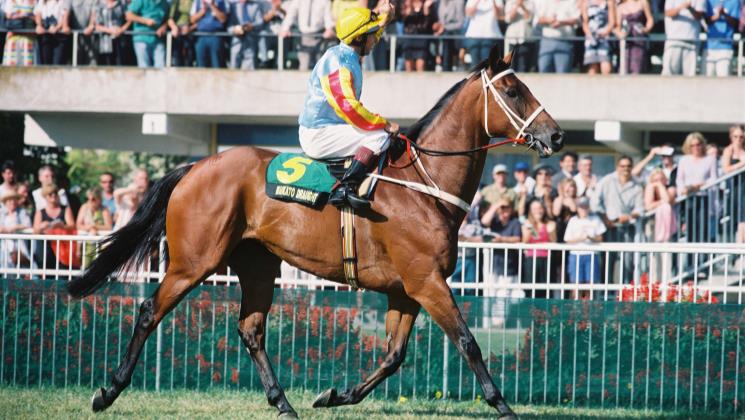
Legends of the Hastings Turf
Quality thoroughbreds have been strutting their stuff at Hastings for almost 150 years.
The Hawke’s Bay Cup was first run in 1875, the Hawke’s Bay Steeplechase in 1879 and the inaugural Hawke’s Bay Guineas was staged at the Hawke’s Bay Jockey Club’s spring meeting in 1880.
The Guineas is still run in the spring, as an attractive support act to the Hawke’s Bay Triple Crown.
The weight-for-age Triple Crown has helped the three-day spring meeting at Hastings become one of the key events on the domestic racing calendar.
The 2022 carnival begins on 10 September. The Tarzino Trophy (1400m) is the first day feature with the Arrowfield Stud Plate (1600m) on 1 October and the Livamol Classic (2040m) a fortnight later.
The Triple Crown series is a comparatively modern development and did not begin till 1999, at which point the Livamol Classic was the only one of the three races to have Group I status.
Even the Livamol, which has been previously known as the Ormond Memorial, Beamish Stakes, Kelt Stakes and NZB Spring Classic, did not gain Group I status till 1996 and was still a Group III race in 1992.
It was 2005 before all three races in the Triple Crown achieved a Group I rating.
Spare a thought for the top class Awapuni galloper Calm Harbour, who, in 1993, beat Veandercross and Cox Plate winner Solvit in the Tarzino and Solvit and Castletown in the Livamol and was unable to claim a Group I win in either case.
The Livamol was staged in the autumn for many years, and the Tarzino Trophy also had an autumn date before both races were switched to the spring in 1984.
The Tarzino was first held in 1976, when known as the Hawke’s Bay Challenge Stakes, and has had another seven name changes since but the quality of the winners has remained consistently high.
The first four winners were Grey Way, Copper Belt, Silver Liner and Vice Regal who, between them, won 104 races.
Four of the subsequent winners – Poetic Prince, Surfers Paradise, Sunline, and Ocean Park – also won a Cox Plate, and other top class gallopers to triumph in the 1980s and 90s included Gold Hope, Burletta, Rough Habit, Catering King, Flying Luskin, Snap and Hero.
There has been no drop in quality this century, with Sunline and Ocean Park joined by Starcraft, Xcellent, Seachange, Melody Belle, Mufhasa, Miss Potential, Kawi, Tavistock and Cent Home.
The Tarzino had a Group III rating for the first few years but then became a Listed race, before being promoted back to Group III in 1991. It became a Group II race three years later and was upgraded to Group I in 2003, the year after Sunline’s win.
The Livamol was rated a Group III when the Group and Listed pattern was introduced in New Zealand, in the 1977-78 season, and remained at that level till 1993, despite being won by the likes of Balmerino, La Mer (twice), Commissionaire (twice), Lomondy (twice) and Castletown, with the race upgraded following Veandercross’ victory in 1992.
It earned Group I status in 1996 and subsequently became New Zealand’s premier weight-for-age race, particularly during a period when the stake rose rapidly, due in part to strong support from principal sponsor Sam Kelt. The stake rose from $250,000 in 2000 to $1 million in 2004, 2005 and 2006 and hit $2 million in 2007 and 2008.
Princess Coup’s connections were the main benefactors from the $2m races, with the mare earning the $1.15m first prize both times.
The stake dropped to $1.2m in 2009, when won by Vosne Romanee. That was the end of the golden weather for the race. The stake dropped to $250,000 the following year and has been at either $250,000 or $300,000 since.
The Windsor Park was first run in 1997, when a 1400m handicap named the Horlicks Plate. At that time, the Hastings spring meeting had only two premier days and the Horlicks Plate was run on the same day as the Livamol.
However, following a bold decision to extend the carnival to three premier days, the race was changed to a 1600m weight-for-age in 1999 and run on the middle day, thus establishing a three-race series.
Just Call Me Sir, who had won the Livamol the previous year as a three-year-old, won the inaugural running of the Windsor Park but because of a change in conditions and date, the race did not have even listed status. However, it became a Group III race the following year.
Rebel was placed in all three legs when the Triple Crown was launched and The Message won the last two legs in 2000 but it took 20 years to produce the first Triple Crown winner, when Melody Belle triumphed in 2019.
Melody Belle enjoyed her trips to Hastings and has was unbeaten in seven starts on the track, all in Triple Crown races.







